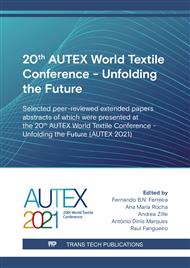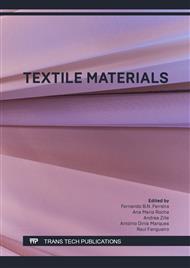[1]
R. Gassert, V. Dietz, Rehabilitation robots for the treatment of sensorimotor deficits: a neurophysiological perspective, Journal of NeuroEngineering and Rehabilitation. 15 (2018) 46.
DOI: 10.1186/s12984-018-0383-x
Google Scholar
[2]
C. Bayón, T. Martín-Lorenzo, B. Moral-Saiz, Ó. Ramírez, Á. Pérez-Somarriba, S. Lerma-Lara, I. Martínez, E. Rocon, A robot-based gait training therapy for pediatric population with cerebral palsy: goal setting, proposal and preliminary clinical implementation, Journal of NeuroEngineering and Rehabilitation. 15 (2018) 69.
DOI: 10.1101/255448
Google Scholar
[3]
K.P. Michmizos, H.I. Krebs, Pediatric robotic rehabilitation: Current knowledge and future trends in treating children with sensorimotor impairments, NeuroRehabilitation. 41 (2017) 69–76. https://doi.org/10.3233/NRE-171458.
DOI: 10.3233/nre-171458
Google Scholar
[4]
T.C. Bulea, Z.F. Lerner, A.J. Gravunder, D.L. Damiano, Exergaming with a pediatric exoskeleton: Facilitating rehabilitation and research in children with cerebral palsy, IEEE Int Conf Rehabil Robot. 2017 (2017) 1087–1093.
DOI: 10.1109/icorr.2017.8009394
Google Scholar
[5]
J.-S. Bourseul, S. Brochard, L. Houx, C. Pons, M. Bué, I. Manesse, J. Ropars, D. Guyader, P. Le Moine, A. Dubois, Care-related pain and discomfort in children with motor disabilities in rehabilitation centres, Annals of Physical and Rehabilitation Medicine. 59 (2016) 314–319.
DOI: 10.1016/j.rehab.2016.04.009
Google Scholar
[6]
E.A. Lyons, D.E. Jones, V.M. Swallow, C. Chandler, An Exploration of Comfort and Discomfort Amongst Children and Young People with Intellectual Disabilities Who Depend on Postural Management Equipment, J Appl Res Intellect Disabil. 30 (2017) 727–742.
DOI: 10.1111/jar.12267
Google Scholar
[7]
S. Ashkenazy, F. DeKeyser Ganz, The Differentiation Between Pain and Discomfort: A Concept Analysis of Discomfort, Pain Management Nursing. 20 (2019) 556–562.
DOI: 10.1016/j.pmn.2019.05.003
Google Scholar
[8]
L. Abou-Abbas, H. Fersaie Alaie, C. Tadj, Automatic detection of the expiratory and inspiratory phases in newborn cry signals, Biomedical Signal Processing and Control. 19 (2015) 35–43.
DOI: 10.1016/j.bspc.2015.03.007
Google Scholar
[9]
A. Rosales-Pérez, C.A. Reyes-García, J.A. Gonzalez, O.F. Reyes-Galaviz, H.J. Escalante, S. Orlandi, Classifying infant cry patterns by the Genetic Selection of a Fuzzy Model, Biomedical Signal Processing and Control. 17 (2015) 38–46.
DOI: 10.1016/j.bspc.2014.10.002
Google Scholar
[10]
C. Kirschbaum, K.-M. Pirke, D.H. Hellhammer, The Trier Social Stress Test, – A Tool for Investigating Psychobiological Stress Responses in a Laboratory Setting, NPS. 28 (1993) 76–81.
DOI: 10.1159/000119004
Google Scholar
[11]
A.D. Deacy, L.A. Gayes, S. De Lurgio, D.P. Wallace, Adaptation of the State-Trait Inventory for Cognitive and Somatic Anxiety for Use in Children: A Preliminary Analysis, J Pediatr Psychol. 41 (2016) 1033–1043.
DOI: 10.1093/jpepsy/jsw030
Google Scholar
[12]
N.C. a. C. Oliveira, C.M. Gaspardo, M.B.M. Linhares, Pain and distress outcomes in infants and children: a systematic review, Braz. J. Med. Biol. Res. 50 (2017) e5984.
DOI: 10.1590/1414-431x20175984
Google Scholar
[13]
(PDF) The Utility of Measures of Child and Adolescent Anxiety: A Meta-Analytic Review of the Revised Children's Manifest Anxiety Scale, the State–Trait Anxiety Inventory for Children, and the Child Behavior Checklist, ResearchGate. (n.d.). 10.
DOI: 10.1207/s15374424jccp3303_13
Google Scholar
[14]
I. Locher, Technologies for system-on-textile integration, Doctoral Thesis, ETH Zurich, (2006).
Google Scholar
[15]
(PDF) Stress Detection Using Physiological Sensors, ResearchGate. (n.d.).
Google Scholar
[16]
G. Vila, C. Godin, S. Charbonnier, E. Labyt, O. Sakri, A. Campagne, Pressure-Specific Feature Selection for Acute Stress Detection From Physiological Recordings, in: IEEE International Conference on Systems, Man, and Cybernetics, IEEE SMC 2018, Mysaki, Japan, 2018. https://hal.archives-ouvertes.fr/hal-01971692 (accessed September 22, 2020).
DOI: 10.1109/smc.2018.00402
Google Scholar
[17]
R. Paradiso, G. Loriga, N. Taccini, A wearable health care system based on knitted integrated sensors, IEEE Transactions on Information Technology in Biomedicine. 9 (2005) 337–344.
DOI: 10.1109/titb.2005.854512
Google Scholar
[18]
M. Di Rienzo, F. Rizzo, G. Parati, G. Brambilla, M. Ferratini, P. Castiglioni, MagIC System: a New Textile-Based Wearable Device for Biological Signal Monitoring. Applicability in Daily Life and Clinical Setting, in: 2005 IEEE Engineering in Medicine and Biology 27th Annual Conference, 2005: p.7167–7169.
DOI: 10.1109/iembs.2005.1616161
Google Scholar
[19]
L. Hu, M. Pasta, F. La Mantia, L. Cui, S. Jeong, H.D. Deshazer, J.W. Choi, S.M. Han, Y. Cui, Stretchable, Porous, and Conductive Energy Textiles, Nano Lett. 10 (2010) 708–714.
DOI: 10.1021/nl903949m
Google Scholar
[20]
C. Rovira, S. Coyle, B. Corcoran, D. Diamond, F. Stroiescu, K. Daly, Integration of textile-based sensors and Shimmer for breathing rate and volume measurement, in: 2011 5th International Conference on Pervasive Computing Technologies for Healthcare (PervasiveHealth) and Workshops, 2011: p.238–241.
DOI: 10.4108/icst.pervasivehealth.2011.246104
Google Scholar
[21]
E.S. Kolosovas-Machuca, M.A. Martínez-Jiménez, J.L. Ramírez-GarcíaLuna, F.J. González, A.J. Pozos-Guillen, N.P. Campos-Lara, M. Pierdant-Perez, Pain Measurement through Temperature Changes in Children Undergoing Dental Extractions, Pain Res Manag. 2016 (2016) 4372617.
DOI: 10.1155/2016/4372617
Google Scholar
[22]
S. Jung, T. Ji, V.K. Varadan, Point-of-care temperature and respiration monitoring sensors for smart fabric applications, Smart Mater. Struct. 15 (2006) 1872–1876.
DOI: 10.1088/0964-1726/15/6/042
Google Scholar
[23]
H. Gidik, D. Dupont, G. Bedek, Development of a radiative heat fluxmeter with a textile substrate, Sensors and Actuators A: Physical. 271 (2018).
DOI: 10.1016/j.sna.2017.12.020
Google Scholar
[24]
H. Gidik, G. Bedek, D. Dupont, C. Codau, Impact of the textile substrate on the heat transfer of a textile heat flux sensor, Sensors and Actuators A: Physical. 230 (2015) 25–32.
DOI: 10.1016/j.sna.2015.04.001
Google Scholar
[25]
C.-T. Huang, C.-L. Shen, C.-F. Tang, S.-H. Chang, A wearable yarn-based piezo-resistive sensor, Sensors and Actuators A: Physical. 141 (2008) 396–403.
DOI: 10.1016/j.sna.2007.10.069
Google Scholar



